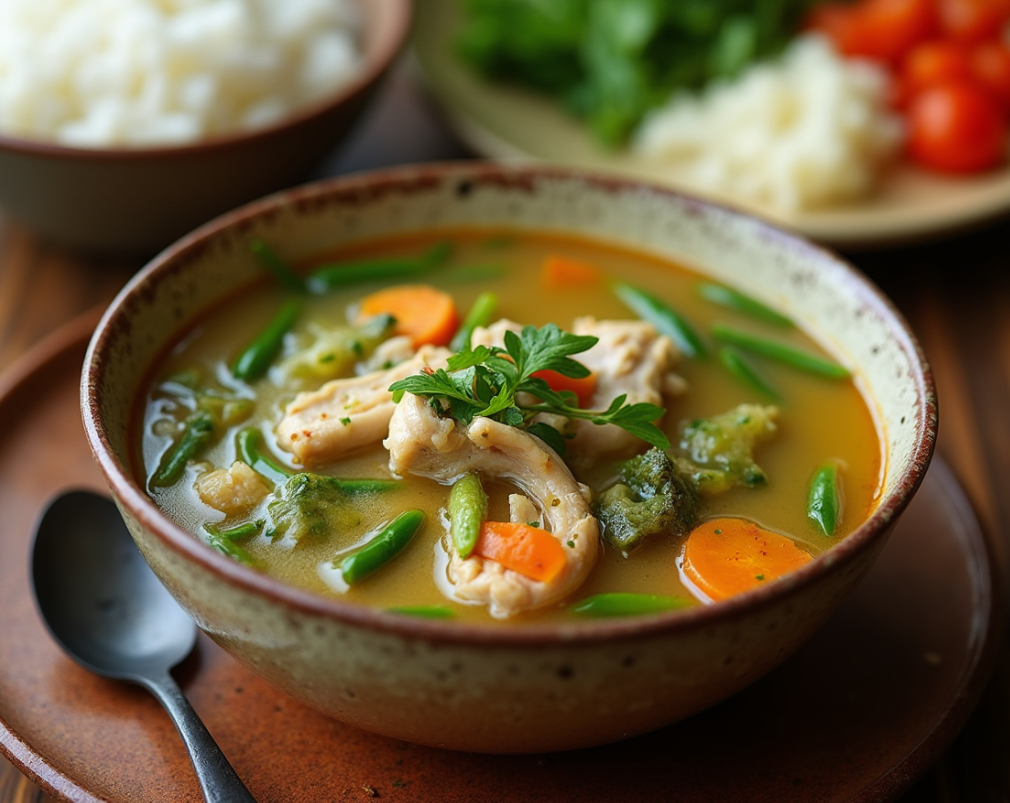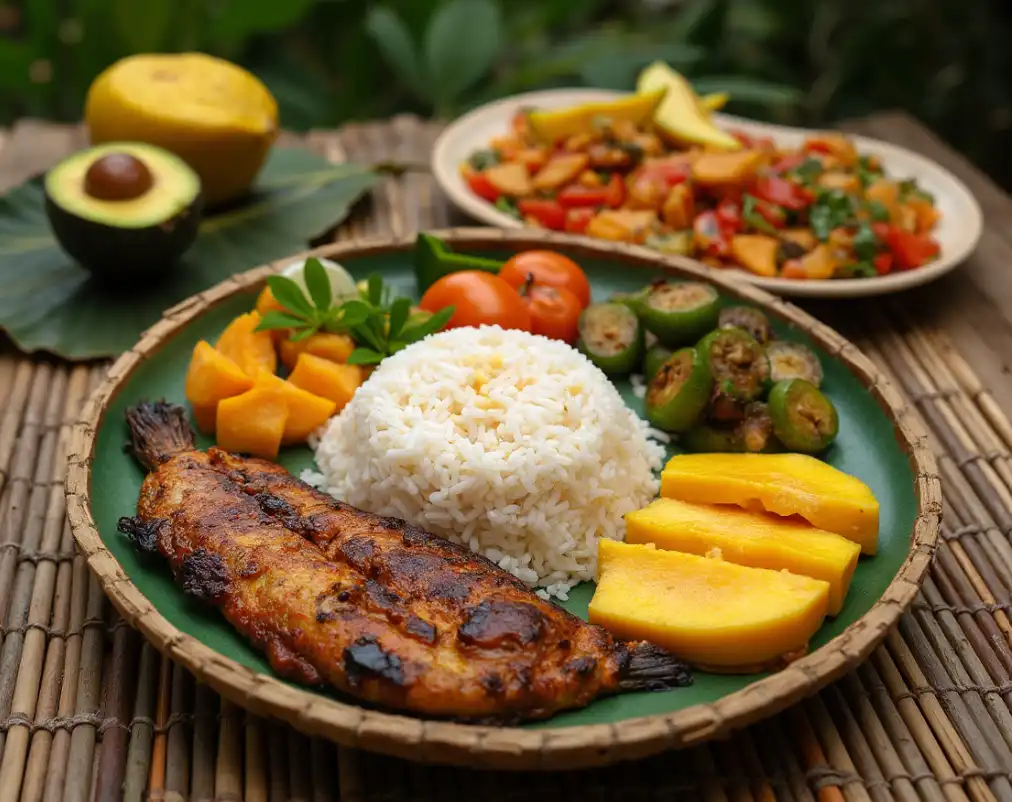The Philippines boasts a rich culinary tradition that mirrors its vibrant history and diverse culture. But one common question asked by many is: “Is Philippine food healthy?” With its mix of indigenous, Spanish, Chinese, and American influences, the cuisine is flavorful and unique. However, its healthfulness often depends on ingredients, preparation methods, and portion sizes. Understanding Filipino food and its potential impact on health requires an exploration of its staples, traditional dishes, and modern adaptations.
Table of Contents
Nutritional Aspects and Health benefits of Filipino food

Filipino cuisine beautifully combines vibrant flavors and textures, reflecting the country’s rich history. Furthermore, beyond its taste, its nutritional value stands out through staple ingredients, cooking methods, and balanced nutrients, ultimately revealing its true health potential.
Staple Ingredients in Philippine Food
The foundation of Filipino cuisine lies in its diverse ingredients, many of which offer substantial nutritional benefits.
- Rice:
Rice is a staple in most Filipino meals, serving as a primary source of energy. While white rice is widely consumed, brown or red rice offers higher fiber content, aiding digestion and promoting heart health. - Vegetables:
Vegetables such as malunggay (moringa), kangkong (water spinach), and squash are commonly used. These are nutrient-dense, rich in vitamins A and C, and offer fiber that helps maintain digestive health. - Seafood and Protein Sources:
The Philippines, being an archipelago, has abundant seafood like fish, prawns, and shellfish. These are high in omega-3 fatty acids, which benefit heart health. Pork, chicken, and beef are also widely used, providing necessary proteins, though they should be consumed in moderation to avoid excess saturated fats. - Fruits:
Tropical fruits like mangoes, bananas, and papayas are not only delicious but also rich in vitamins, antioxidants, and natural sugars for energy.
Role of Cooking Methods
How food is prepared plays a significant role in its health impact. Traditional Filipino cooking often leans on methods that can either enhance or diminish nutritional value.
- Steaming and Boiling:
These methods are commonly used for dishes like sinigang (a sour soup) and tinola (chicken soup). They preserve the nutrients in vegetables and proteins while avoiding added fats. - Grilling:
Grilling, as seen in dishes like inihaw na isda (grilled fish), can be a healthy option if done without excessive marinades high in sugar or salt. - Frying:
Fried foods, such as lumpiang shanghai (fried spring rolls) or lechon kawali (crispy pork belly), are popular but should be consumed sparingly due to their high calorie and fat content.
Balance of Nutrition in Philippine food
Filipino meals typically balance carbohydrates, proteins, and fats. However, the ratio often varies depending on the dish.
- High-Carb Dishes:
Dishes like pancit (noodles) and rice-heavy meals can be high in carbohydrates, which provide energy but may lead to weight gain if consumed in excess. - Protein and Fats:
Proteins from seafood and lean meats are healthy choices, but high-fat options like chicharon (fried pork rinds) or adobo with excessive oil can contribute to heart-related issues. - Micronutrient Diversity:
Thanks to its variety of ingredients, Filipino cuisine often provides a good mix of vitamins and minerals, including vitamin C from calamansi and iron from leafy greens.
Traditional Dishes and Their Health Impacts
Filipino cuisine is a tapestry of traditional dishes, each offering a unique combination of flavors and nutritional value. While many traditional meals are wholesome and nutrient-rich, others lean toward indulgence. Understanding these dishes’ health impacts allows for informed dietary choices.
Traditional Healthy Filipino dishes
Several Filipino dishes stand out for their nutritional benefits, thanks to the emphasis on fresh ingredients and balanced cooking methods.

- Tinola:
Tinola, a chicken soup with ginger, green papaya, and malunggay leaves, is low in fat, rich in vitamins, and packed with iron and antioxidants. - Sinigang:
Known for its tangy flavor, sinigang is often made with fish or pork and loaded with vegetables like radish, eggplant, and okra. The sour broth, derived from tamarind or similar souring agents, stimulates appetite while being low in calories. - Ensaladang Talong:
This grilled eggplant salad mixed with tomatoes, onions, and sometimes salted eggs is light, refreshing, and high in dietary fiber and antioxidants. - Ginisang Gulay (Sauteed Vegetables):
These dishes vary depending on the vegetables used but are typically cooked with minimal oil, retaining most of their nutritional benefits.
Moderation and Unhealthy Choices
While Filipino cuisine has its healthy staples, some dishes are best enjoyed in moderation due to their high fat, sodium, or calorie content.

- Crispy Pata:
Deep-fried pork knuckles are undeniably delicious but high in saturated fats, which can contribute to cholesterol issues if consumed frequently. - Lechon:
A Filipino party is incomplete without lechon, a whole roasted pig. Though flavorful, its crispy skin and juicy meat are calorie-dense and should be eaten sparingly. - Excessive Fried Dishes:
Lumpiang shanghai, ukoy (shrimp fritters), and other fried snacks are high in trans fats and may lead to weight gain and cardiovascular issues when consumed in large quantities.
Adaptations for Modern Diets
Modern Filipino cuisine has evolved to cater to contemporary dietary preferences, offering healthier alternatives without sacrificing taste.
- Vegan and Plant-Based Versions:
Classic dishes like adobo and kare-kare (peanut stew) now have vegan adaptations using tofu, jackfruit, or plant-based meat alternatives. - Gluten-Free Options:
Traditional rice-based snacks such as suman (sticky rice rolls) and bibingka (rice cakes) are naturally gluten-free and ideal for those with dietary restrictions. - Low-Carb Variations:
Using cauliflower rice or shirataki noodles, modern versions of rice-heavy or noodle dishes have emerged, appealing to low-carb and keto dieters.
Explore the nutritional benefits of Sinigang, one of the most iconic dishes in Philippine cuisine, to understand its role in a balanced Filipino diet.
Influence of Filipino Culture on Eating Habits
Filipino cuisine reflects the country’s rich culture, with communal eating and celebration foods shaping meal preparation and habits. These practices foster togetherness but can also affect overall health.
Communal Eating and Its Effects
Sharing meals is a cornerstone of Filipino culture. The concept of “salu-salo” (a communal feast) embodies family and community values.
- Portion Control:
Communal eating encourages balanced portion sizes, as family-style meals let individuals take small servings of multiple dishes. - Encouraging Variety:
The diversity of dishes on a Filipino dining table means more exposure to various nutrients, as meals typically include vegetables, proteins, and carbs. - Social Benefits:
Eating together promotes emotional well-being, reduces stress, and fosters stronger social connections—factors indirectly contributing to better health.
Celebration Foods and Excess
Festive occasions in the Philippines, such as fiestas, birthdays, and holidays, are synonymous with bountiful feasts. These events often showcase the richness of Filipino cuisine, but they can lead to overindulgence, prompting many to ask, “Is Philippine food healthy?”
- Calorie-Dense Dishes:
Dishes like lechon, pancit, and various kakanin (sticky rice desserts) are staples during celebrations. While delicious, they often come with high calorie and sugar content. - Unconscious Overeating:
The festive atmosphere and abundance of food encourage multiple servings, which can lead to excessive calorie consumption. - Cultural Significance vs. Health:
While celebration foods are an integral part of Filipino identity, balancing indulgence with moderation is key to maintaining health.
Traditional Beliefs About Filipino cuisine and health
Filipino health practices often reflect a mix of indigenous beliefs and influences from various cultures.
- Hot and Cold Foods:
Traditional Filipino medicine emphasizes the balance of hot and cold foods to maintain health. For example, people often pair cooling foods like cucumber or mung beans with warming foods like ginger or chicken. - Healing Ingredients:
Ginger (salabat) tea and turmeric (luyang dilaw) provide anti-inflammatory benefits, while calamansi offers high vitamin C content. - Superstitions and Practices:
Eating certain foods at specific times promotes health according to tradition. For instance, sticky rice-based desserts during the New Year symbolize family togetherness and prosperity.
Common Misconceptions About Nutrition in Philippine food
Filipino cuisine, rich in flavors, is often questioned: Is Philippine food healthy? Clearing misconceptions highlights its nutritional benefits and cultural value.
“Too Much Rice” Misconception
Rice is often criticized as being unhealthy due to its carbohydrate content. However, its role in Filipino meals is more nuanced.
- Source of Sustained Energy:
Rice serves as a primary energy source for Filipinos, particularly those engaged in physically demanding activities. - Portion Matters:
The problem isn’t rice itself but the portion size. Large servings can lead to an excessive caloric intake, but moderate portions paired with vegetables and proteins provide a balanced meal. - Healthier Alternatives Exist:
Brown rice, red rice, or quinoa are nutrient-dense options that add fiber and other vitamins to the diet while maintaining cultural preferences.
The Myth of “Unhealthy” Filipino Food
Some believe Filipino food is inherently unhealthy due to its frequent use of fried and fatty ingredients. However, this perception overlooks the variety within the cuisine.
- Diverse Preparation Methods:
While fried dishes like lumpia and crispy pata are popular, Filipino cuisine also includes healthy cooking methods like steaming (paksiw), boiling (nilaga), and grilling (inihaw). - Focus on Freshness:
Many dishes use fresh ingredients like seafood, leafy greens, and tropical fruits, which are nutrient-rich and flavorful without needing heavy seasoning or sauces. - Traditional Health Foods:
Soups like sinigang and tinola, rich in vegetables and lean proteins, showcase the cuisine’s potential for providing balanced and nutritious meals.
Addressing Sodium Concerns
Filipino dishes are often seen as salty due to condiments like soy sauce, fish sauce, and shrimp paste. Using them sparingly makes meals healthier.
- Mindful Usage:
Using these condiments sparingly and relying more on herbs and natural flavorings like ginger or garlic can reduce sodium intake. - Healthier Alternatives:
Low-sodium soy sauce or salt-free spice blends can replace traditional options without compromising taste. - Education on Hidden Sodium:
Awareness of processed products, such as canned goods or pre-packaged mixes, is essential for reducing overall salt consumption in Filipino meals.
Health Beyond Calories
Another common misconception is that Filipino cuisine’s rich flavors come at the expense of health. In reality, its emphasis on diverse ingredients contributes to overall well-being.
- Nutrient-Dense Staples:
Ingredients like malunggay, turmeric, and calamansi are staples in Filipino cooking, offering significant health benefits such as boosting immunity and reducing inflammation. - Room for Modernization:
Filipino cuisine is adaptable, allowing for healthier modern interpretations that fit contemporary health goals without losing its essence.
Eating Tips for Enjoying Healthy Filipino dishes
Filipino cuisine offers delicious dishes that can be part of a healthy diet with mindful preparation and portion control. The question “Is Philippine food healthy?” depends on ingredients, cooking methods, and balanced choices, making it both indulgent and nutritious.
Choosing Healthier Cooking Methods

The cooking methods used in Filipino cuisine significantly affect the overall health profile of meals. Opting for healthier preparation techniques can reduce unhealthy fats and calories.
- Steaming and Boiling:
Steaming fish and vegetables or boiling soups like tinola or sinigang is an excellent way to retain nutrients while avoiding added oils. - Grilling Over Frying:
Grilled options like inihaw na manok (grilled chicken) or inihaw na bangus (grilled milkfish) contain less fat than fried alternatives. - Air Fryers for Modern Kitchens:
For dishes traditionally fried, such as lumpia or chicharon, using an air fryer can significantly cut down on oil while preserving the crisp texture.
Portion Control Strategies
One of the easiest ways to make Filipino meals healthier is by managing portion sizes. Traditional meals often include multiple dishes, making portion control crucial.
- Smaller Servings of Rice:
Start with half a cup of rice and add more vegetables or protein to your plate instead. - Mindful Eating:
Serve food in smaller plates and eat slowly to enjoy the flavors and feel satisfied with less. - Share Dishes:
Filipinos often serve meals family-style, which makes it easier to take small portions of several dishes instead of indulging in one calorie-dense item.
Incorporating More Vegetables and Fruits
Adding fresh produce to the meal makes Filipino dishes more balanced.
- Vegetable-Heavy Variations:
Increase the proportion of vegetables in dishes like pinakbet (vegetable stew) or ginisang gulay (sauteed vegetables). - Creative Substitutions:
Replace less nutritious ingredients with vegetables, such as using eggplant slices instead of noodles in lasagna-style baked dishes. - Fresh Fruit Desserts:
Substitute sugary treats with natural options like sliced mangoes, bananas, or a fresh fruit salad.
Reducing Salt, Sugar, and Fat for Healthy Filipino dishes
Is Philippine food healthy given Filipino cuisine’s bold flavors often come from high-sodium, high-sugar, or high-fat ingredients? Making small adjustments can preserve taste while improving health.
- Lower-Sodium Options:
Use light soy sauce or fish sauce alternatives, and limit salty condiments like bagoong. - Natural Sweeteners:
Replace refined sugar with natural sweeteners like coconut sugar or honey in desserts like turon or leche flan. - Limit Oil:
Reduce the amount of cooking oil in recipes and opt for healthier oils like olive oil or coconut oil when necessary.
Incorporating Activity and Hydration
To balance the indulgence of Filipino food, maintain an active lifestyle and stay hydrated.
- Stay Active After Meals:
Activities like walking after meals can help with digestion and manage calorie intake. - Drink Water:
Drink plenty of water instead of sugary beverages like soda or sweetened iced tea.
FAQs
Can you eat Filipino food on a diet?
Yes, Filipino food can fit into a healthy diet with mindful choices. If you’ve wondered, is Philippine food healthy, the answer depends on preparation and portions. Choose grilled or boiled dishes over fried ones, add more vegetables and lean proteins, and moderate rice servings. Opting for steaming or grilling and managing portions lets you enjoy Filipino flavors while maintaining your health.
Are there healthy Filipino desserts?
Absolutely! While some Filipino desserts can be calorie-dense, there are healthier options. For example:
- Turon: Bananas wrapped in spring roll wrappers create turon, which you can bake instead of fry for a lower-calorie version.
- Bibingka: This rice cake offers a naturally gluten-free option, and using coconut sugar adds a healthier twist.
- Fresh Fruits: Tropical fruits like mango, papaya, and pineapples are naturally sweet and nutrient-rich alternatives to traditional sugary desserts.
How do traditional spices and herbs benefit health?
Traditional Filipino spices and herbs are packed with health benefits.
- Garlic: Commonly used in adobo and sinangag (fried rice), garlic has anti-inflammatory and heart-health properties.
- Ginger: Found in tinola and salabat (ginger tea), it aids digestion and boosts immunity.
- Turmeric: Used in dishes like kare-kare, turmeric is known for its anti-inflammatory and antioxidant properties.
- Calamansi: A small citrus fruit often used as a condiment or in drinks, calamansi is rich in vitamin C, supporting immunity and skin health.
How can Filipino cuisine be made more heart-friendly?
Making Filipino food heart-friendly involves reducing saturated fats, sodium, and sugars. Here are some tips:
- Use Lean Proteins: Replace fatty cuts of pork and beef with chicken, fish, or plant-based options like tofu.
- Reduce Salt: Substitute traditional salty condiments like soy sauce and bagoong with herbs and spices for flavor.
- Limit Frying: Choose grilling, boiling, or steaming as healthier cooking methods.
- Incorporate Whole Grains: Switch from white rice to brown or red rice for more fiber and lower glycemic impact.
Can you maintain a vegetarian or vegan diet with Filipino food?
Filipino cuisine adapts well to vegetarian and vegan diets. Dishes like pinakbet (vegetable stew) are naturally vegetarian, and vegan versions of adobo or kare-kare use tofu or jackfruit as meat substitutes. This flexibility highlights that Filipino recipes can easily cater to modern dietary preferences, addressing the question, “Is Philippine food healthy?”
Conclusion
Filipino cuisine offers a blend of healthy and indulgent options, relying on fresh ingredients like vegetables, seafood, and tropical fruits. Is Philippine food healthy? Traditional methods like steaming and grilling highlight its potential for healthy eating. While some dishes are calorie-rich, portion control and healthier alternatives can balance them.
Cultural practices, such as communal dining and traditional health beliefs, shape dietary habits and add depth to the cuisine. With modern adaptations and mindful choices, Filipino food can be both delicious and part of a balanced, nutritious diet.

